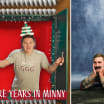Lindsay, Red Wings icon, dies at 93
Member of legendary "Production Line," Hockey Hall of Famer won Stanley Cup four times with Detroit
Red Wings legend Ted Lindsay dies at 93
Known as Terrible Ted for his ferocity on the ice, Lindsay won the
Art Ross Trophy
in 1950 as the top scorer in the NHL, played in the NHL All-Star Game 11 consecutive seasons (1947-57), was selected to the NHL First All-Star Team eight times, and finished among the League's top three in goals four times and points six times.
"The National Hockey League mourns the passing and celebrates the incomparable life of the legendary Ted Lindsay," NHL Commissioner Gary Bettman said. "One of the game's fiercest competitors during his 17-season NHL career, he was among its most beloved ambassadors throughout the more than five decades of service to hockey that followed his retirement. In Detroit he was a civic icon.
RELATED: [Stubbs: Lindsay had 'something' special | Ted Lindsay: 100 Greatest NHL Players\]
"What Lindsay lacked in physical stature he possessed in intensity, desire and will to win. He played 1,068 NHL games for the Detroit Red Wings and Chicago Blackhawks, scoring 379 goals with 472 assists and 1,808 penalty minutes. He appeared in 11 All-Star Games and was named a First-Team All-Star eight times. He won the Art Ross Trophy as the League's scoring leader in 1950, and as a driving force on the dynastic Red Wings teams of the 1950s -- including as the left wing on the famed 'Production Line' -- he won the Stanley Cup four times.
"Named to the Hockey Hall of Fame in 1966, he had his No. 7 retired by the Red Wings in 1991 and was named one of the NHL's Top 100 Players during the League's Centennial Celebration in 2017. As influential off the ice as he was on the ice, Lindsay was instrumental in the formation of the NHL Players' Association. In 2010, NHL players displayed their reverence for him by renaming their annual award for the most outstanding player the Ted Lindsay Award."
Lindsay played 1,068 NHL games from 1944-45 through 1964-65, coming out of a four-year retirement in 1964 after three seasons with the Chicago Black Hawks to play one final season with the Red Wings, with whom he broke into the NHL.
He is survived by his children Blake, Lynn and Meredith, stepdaughter Leslie, six grandchildren and three great-grandchildren.
Chris Chelios discusses his memories of Ted Lindsay
"Ted was a persistent, courageous and determined man both on and off the ice," the Lindsay family said. "He was a man of many firsts. We are comforted in knowing that the Ted Lindsay legacy will forever be a part of history and are so proud of the many lives he helped change for the better through his tireless humanitarian work. Arrangements will be announced when they are finalized."
Lindsay's legacy on and off the ice belied his 5-foot-8, 163-pound stature.
In his heyday with the Red Wings during the 1940s and 1950s, Lindsay was the prototype for players who were told they never would succeed because of their size. Though Lindsay might have appeared slight when compared with many of his peers, the left wing was a four-time 30-goal-scorer.
The 1966 Hockey Hall of Fame inductee's contributions off the ice equally were as important.
Lindsay and Montreal Canadiens defenseman
Doug Harvey
first organized players toward forming a union to fight for better working conditions. Lindsay was subjected to backlash from Detroit ownership and traded to the Black Hawks. But he was rewarded in 2010 when the Lester B. Pearson Award, given to the most outstanding player in the regular season as voted by the players, was renamed the Ted Lindsay Award.
"I was doing it because I believed in it," Lindsay told Canadian Press shortly after the change. "I was doing it not to irritate owners, I was doing it to help out other players]. All of us needed help, we needed a voice as a group, not as an individual."
Lindsay was born July 29, 1925, in Renfrew, Ontario, and was good enough as an 18-year-old junior-hockey player to earn a tryout from the Red Wings before the 1944-45 season. As a 19-year-old rookie that season he scored 17 goals in 45 games. But his career really took off in his fourth NHL season, when he was put on a line with
[Gordie Howe
, a young right wing, and veteran center
Sid Abel
. Lindsay scored 33 goals during their first season together, and they were dubbed "The Production Line."
The linemates finished 1-2-3 in League scoring during the 1949-50 season, when Lindsay had an NHL career-high 55 assists and led the League with 78 points. Just as important were the intangibles he provided, including the extreme competitive nature that earned him the nickname.
"I was gifted with a competitive spirit. I hated to lose," Lindsay once said. "If it meant running over you, through you, spearing you, whatever it took, I was there for one reason and that was to win. If that made me terrible, I guess I deserved that title."
Opponents may not have liked Lindsay, but they spoke of him with tremendous respect.
"It was Ted Lindsay, not Gordie Howe, that caused us the most problems," said Montreal Canadiens star
Maurice Richard
, whose teams lost the Cup Final to Detroit in
1952
,
1954
and
1955
. By then,
Alex Delvecchio
had replaced Abel as the center for Lindsay and Howe on the Production Line, which kept rolling and helped Detroit win four championships in six seasons.
The tradition of players skating around the rink with the Stanley Cup also is traceable to Lindsay, who did it after he won his first championship with Detroit in
1950
against the New York Rangers.
"I never thought I was starting a tradition," Lindsay told the Toledo Blade in 2010. "I wanted to recognize [the people] who paid my salary. It was the fans in the seats. After they presented the Cup to [Red Wings general manager] Jack Adams, they put it in on a table with a tablecloth. I saw it sitting there and I went over and picked it up and took it over to the boards.
"I took it over and had it so people could see the names on the Cup. I went around the ice. I didn't think I was starting a tradition. I was just taking care of the people that paid my salary. The next year the captain that got it, raised it and went around with it. And they said Ted Lindsay started that tradition. I'm honored to have my name with it."
By the mid-1950s, Lindsay had become concerned about the increasing profits NHL owners were making while players did not earn nearly as much as athletes in other pro sports. He and Harvey secretly organized players around the League to form a players' association, which eventually settled out of court with the owners on a number of issues. An official union, which became the NHL Players' Association, was formed in 1967.
"All current and former NHL players lost a true friend with the passing of Ted Lindsay," NHL Players' Association executive director Don Fehr said. "'Terrible Ted' was one of the fiercest competitors to ever play in the NHL, and he enjoyed great success on Detroit's fabled 'Production Line,' helping lead the Red Wings to four Stanley Cup championships. On the ice, Ted Lindsay was one of the best players to ever to put on a pair of skates.
"But his greatest legacy was off the ice. A true trailblazer in seeking to improve conditions for all players, Ted was instrumental in organizing the original Players' Association in 1967. All players, past, current and future, are in his debt. All those who have, and will follow him into the NHL, enjoy improved rights and benefits in large part due to the efforts he made."
Lindsay paid a price for his union activity; Adams stripped him of the captaincy in 1956 and a year later traded him to the Black Hawks, who had made the Stanley Cup Playoffs once since 1946. But Lindsay never doubted he had done the correct thing.
"It wasn't right. It was very simple," he told the Red Wings website in 2010. "I had my talent, and nobody could take that away from me. But you have to be fair in this world. I was one of the people who never worried about stats. I only worried about winning, and I felt that this was my responsibility. The good Lord didn't tap me on the head and say, 'Lindsay, this is your job.' I just felt that it was the proper thing to do."
Lindsay played three seasons in Chicago before retiring in 1960. Meanwhile, the Red Wings struggled after trading Lindsay. Abel, who had returned as coach and became GM after Adams was fired in 1961, reacquired Lindsay's rights and enticed his 39-year-old former linemate to return for the 1964-65 season.
NHL President Clarence Campbell was among those who had reservations about what Lindsay could have left after four years out of the League. But Lindsay erased all doubts by scoring 14 goals and helping the Red Wings top the standings for the first time since he was traded.
"Lindsay has done what I thought to be next to impossible. His comeback is one of the most amazing feats in professional sport," Campbell said.
RELATED: [The world according to Lindsay | Lindsay on foes: 'I had no friends']
Lindsay retired for good in 1965 with 851 points (379 goals, 472 assists) in 1,068 NHL games, as well as 96 points (47 goals, 49 assists) in 133 Stanley Cup Playoff games.
After his retirement Lindsay was a broadcaster for the New York Rangers, then worked as an analyst on NBC national telecasts in the early and mid-1970s. He returned to Detroit as general manager in 1977, and the Red Wings made the playoffs in his first season after missing them for the previous seven seasons. Lindsay remained a presence with the Red Wings for years to come and was one of several Detroit legends who had his own stall in the team's locker room at Joe Louis Arena.
He also was well-known for establishing the Ted Lindsay Foundation, which has been dedicated to finding a cure for autism.
In 2008, a statue of Lindsay was unveiled in the concourse at Joe Louis Arena, next to statues of Howe and Delvecchio. He was named one of the
100 Greatest NHL Players
in 2017.
"I hope it's good, what they would say," he told NHL.com in 2016 when asked how he'd like fans to remember him. "Maybe I didn't always have a good night, but I never cheated them."

















